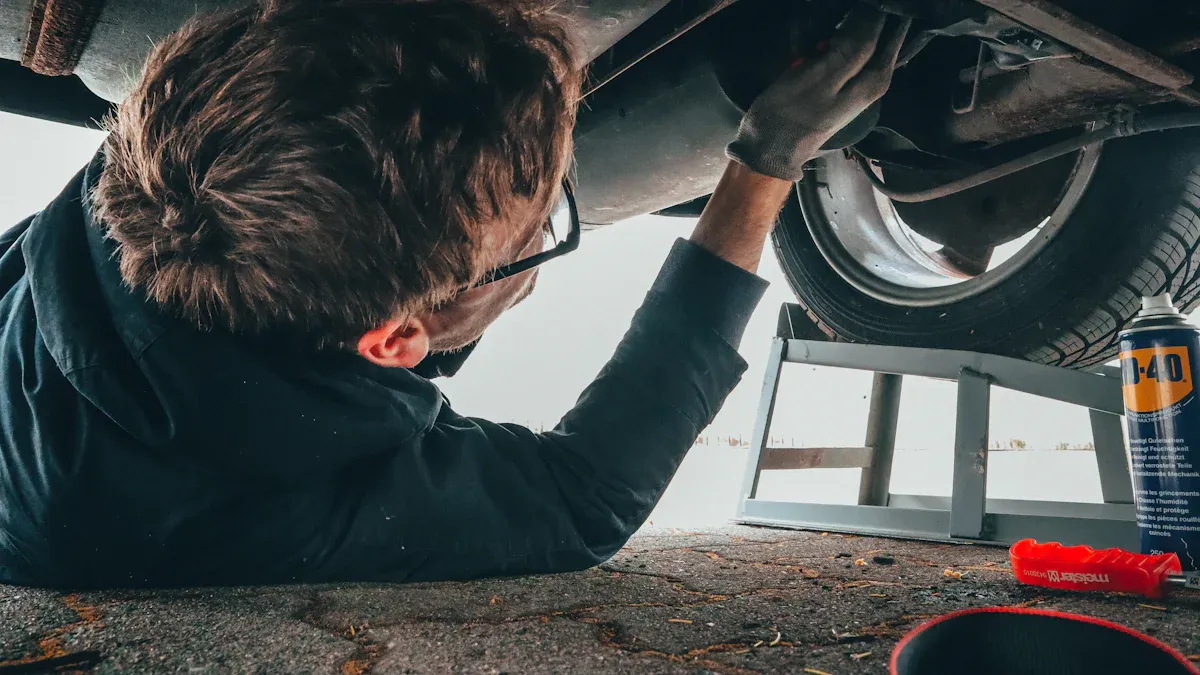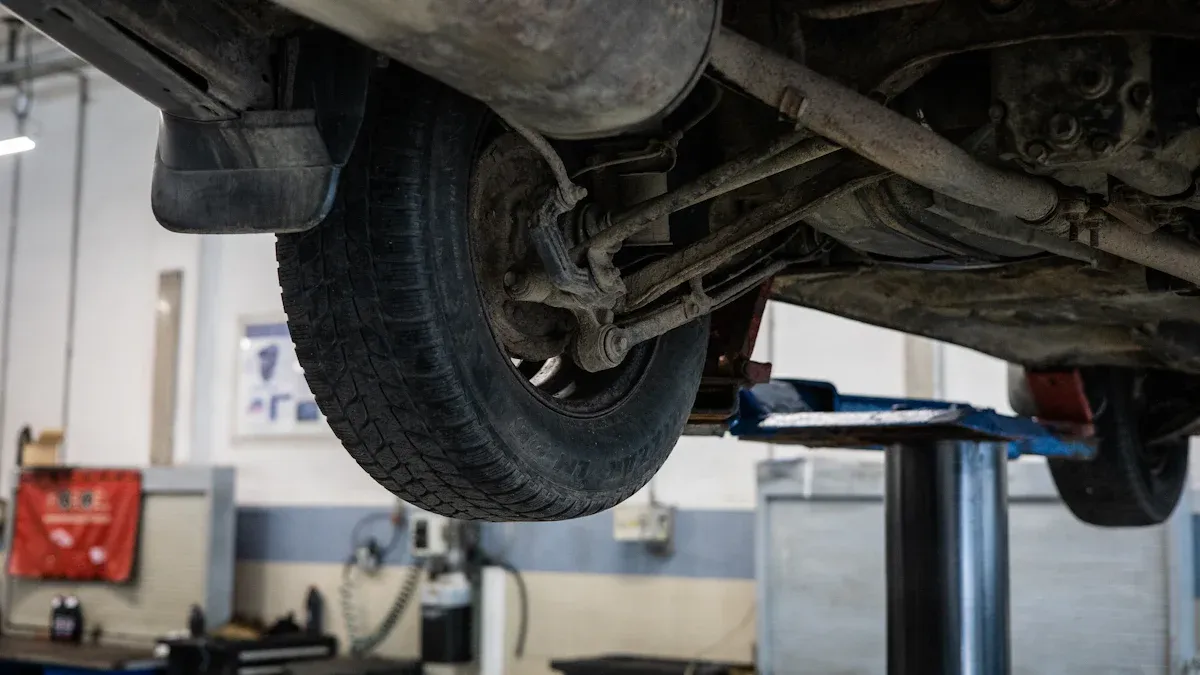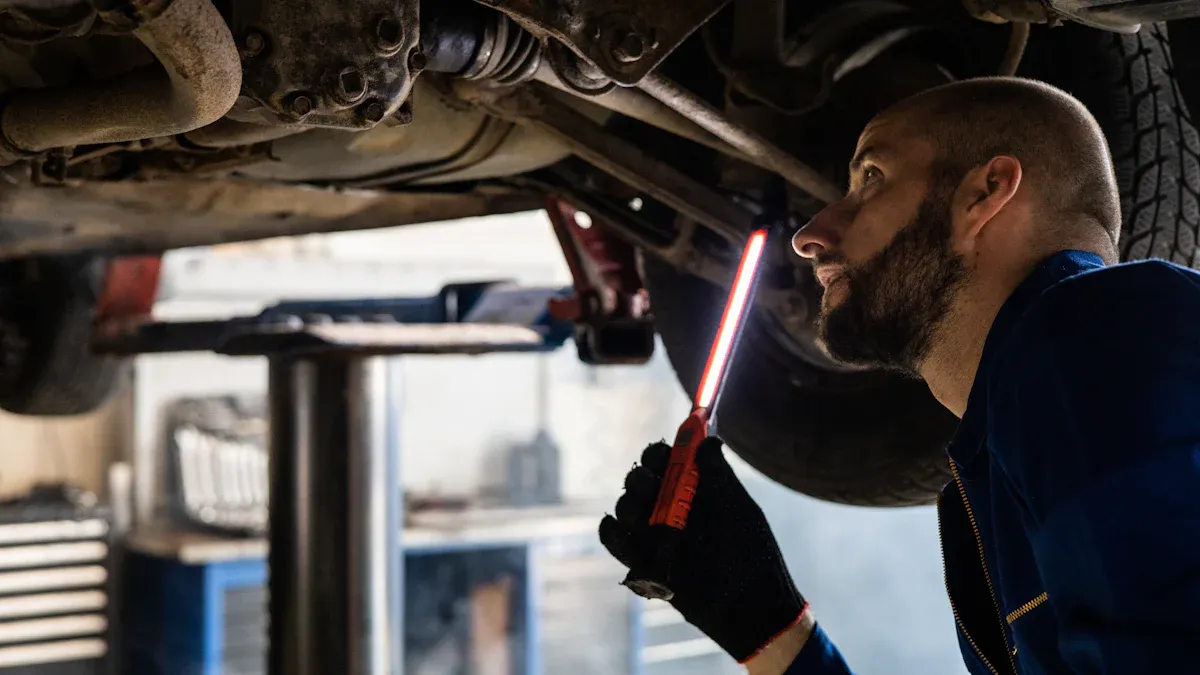
The chassis forms the backbone of any vehicle. It provides structural support, ensuring stability and safety during operation. You rely on it to house critical systems like the suspension, steering, and drivetrain. Understanding how each part functions, including truck chassis parts, helps you maintain your vehicle and optimize its performance.
Key Takeaways
- The chassis is the main frame of a car. It holds the structure and important parts like suspension and steering.
- Taking care of chassis parts, like brakes and suspension, keeps the car safe and working well.
- Spotting problems early, like strange sounds or uneven tires, can save money and make driving smoother.
Structural Parts of the Chassis

Frame
The frame serves as the foundation of your vehicle. It supports the weight of the engine, passengers, and cargo while maintaining the overall structure. Most frames are made of steel or aluminum for durability and strength. You’ll find two main types of frames: ladder frames and unibody frames. Ladder frames are common in larger vehicles like trucks and SUVs, while unibody frames are used in most cars. The frame also absorbs impact during collisions, enhancing safety.
Cross Members
Cross members are horizontal supports that connect different sections of the frame. These components add rigidity and prevent the frame from twisting under stress. You’ll notice their importance when driving over uneven terrain or carrying heavy loads. Cross members also help distribute weight evenly across the chassis, improving stability. In truck chassis parts, cross members play a critical role in ensuring the vehicle can handle demanding tasks.
Subframe
The subframe is a secondary structure attached to the main frame. It houses specific systems like the engine, suspension, or drivetrain. Subframes reduce vibrations and noise, making your ride smoother. They also allow for easier repairs since you can remove and replace them without affecting the entire frame. Many modern vehicles, including those with truck chassis parts, rely on subframes for added flexibility and performance.
Suspension System Components

Springs
Springs are essential for absorbing shocks and maintaining a smooth ride. They support the vehicle’s weight and help keep the tires in contact with the road. You’ll find different types of springs, such as coil springs, leaf springs, and torsion bars. Coil springs are common in cars, while leaf springs are often used in trucks and other heavy-duty vehicles. These components also play a role in balancing the vehicle during turns or when driving over uneven surfaces.
Shock Absorbers
Shock absorbers work alongside springs to control the movement of the suspension. They reduce the bouncing effect caused by uneven roads, ensuring a more stable ride. Without them, your vehicle would feel difficult to handle, especially at higher speeds. Shock absorbers also improve braking performance by keeping the tires firmly planted on the ground. Regular inspection of these parts is crucial for maintaining safety and comfort.
Control Arms
Control arms connect the wheels to the chassis and allow them to move up and down. They act as a pivot point for the suspension system, ensuring proper alignment and stability. You’ll typically find upper and lower control arms in most vehicles. Worn-out control arms can lead to uneven tire wear and poor handling, so it’s important to check them periodically.
Stabilizer Bars
Stabilizer bars, also known as sway bars, reduce body roll when you take sharp turns. They connect the suspension on both sides of the vehicle, distributing weight evenly to maintain balance. This feature is especially important in truck chassis parts, where stability is critical for carrying heavy loads. A damaged stabilizer bar can make your vehicle feel unstable, so replacing it promptly is essential.
Steering System and Truck Chassis Parts
Steering Gear
The steering gear is the heart of your vehicle’s steering system. It translates the movement of the steering wheel into the turning motion of the wheels. This component ensures you can control the direction of your vehicle with precision. There are different types of steering gears, such as rack-and-pinion and recirculating ball systems. Rack-and-pinion systems are common in cars, while recirculating ball systems are often found in larger vehicles, including those with truck chassis parts. Regular maintenance of the steering gear is essential to avoid stiffness or difficulty in steering.
Tie Rods
Tie rods connect the steering gear to the wheels. They play a crucial role in transferring the motion from the steering gear to the tires, allowing you to turn the vehicle. These rods also help maintain proper alignment, ensuring the tires wear evenly and the vehicle handles smoothly. Worn-out tie rods can cause loose steering or uneven tire wear. Inspecting them periodically can prevent costly repairs and improve your driving experience.
Steering Column
The steering column links the steering wheel to the steering gear. It also houses other important components, such as the ignition switch and controls for lights or wipers. Modern steering columns often include collapsible designs to enhance safety during collisions. If you notice unusual noises or difficulty turning the wheel, the steering column might need attention. Keeping this part in good condition ensures smooth and safe operation of your vehicle.
Braking System Components
Brake Calipers
Brake calipers are essential for slowing down your vehicle. They house the brake pads and use hydraulic pressure to press them against the brake rotors. This action creates friction, which helps stop the wheels from spinning. You’ll find two main types of calipers: fixed and floating. Fixed calipers have pistons on both sides, while floating calipers have pistons on one side and slide to apply pressure. Regular inspection of calipers is important. Worn or damaged calipers can reduce braking efficiency and compromise safety.
Brake Rotors
Brake rotors, also known as discs, work with the brake pads to stop your vehicle. When you press the brake pedal, the pads clamp onto the rotors, creating the friction needed to slow down. Rotors come in different designs, such as solid, vented, or drilled. Vented rotors are common in vehicles that need extra cooling, like trucks with heavy loads. Keeping the rotors in good condition ensures smooth braking and prevents vibrations or noise during stops.
Brake Lines
Brake lines carry hydraulic fluid from the master cylinder to the brake calipers. This fluid transfers the force you apply to the brake pedal into the pressure needed to activate the brakes. Brake lines are usually made of steel or reinforced rubber to handle high pressure. Over time, they can develop leaks or corrosion. Inspecting them regularly helps you avoid brake failure. In vehicles with truck chassis parts, durable brake lines are especially important for handling heavy-duty tasks.
Drivetrain Components
Axles
Axles are critical for transferring power from the drivetrain to the wheels. They support the weight of your vehicle and allow the wheels to rotate. You’ll find two main types: live axles and dead axles. Live axles deliver power to the wheels, while dead axles only provide support. In trucks, axles are designed to handle heavy loads, ensuring durability and stability. Regular inspection is essential because worn axles can lead to poor handling or uneven tire wear.
Tip: If you hear clicking noises or feel vibrations while driving, check your axles for damage.
Driveshaft
The driveshaft connects the transmission to the axles, transferring torque to the wheels. It’s a long, rotating tube that plays a key role in your vehicle’s movement. Driveshafts are common in rear-wheel-drive and four-wheel-drive vehicles. They must remain balanced to prevent vibrations and ensure smooth operation. If you notice unusual noises or difficulty accelerating, the driveshaft might need attention.
- Common driveshaft issues include:
- Worn universal joints
- Bent or damaged shafts
Transmission
The transmission controls how power from the engine reaches the wheels. It adjusts the gear ratio to match your speed and driving conditions. You’ll find two main types: manual and automatic transmissions. Manual systems require you to shift gears, while automatic systems handle it for you. Keeping the transmission fluid clean and at the right level ensures smooth gear changes.
Post time: Apr-11-2025

